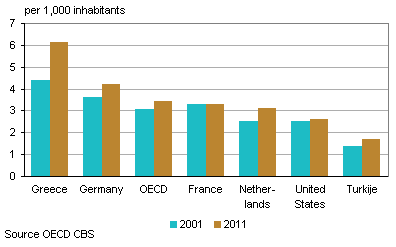Growth in spending on health care in the Netherlands and the OECD levelling off

The growth of spending on health care has been levelling off in recent years in the Netherlands and other OECD countries. Dutch spending, 12 percent of GDP, was well above the OECD average in 2011. The number of medical doctors per one thousand inhabitants is slightly below the average, despite a hefty increase since 2001. The share of people who smoke every day has dwindled in the Netherlands and approached the OECD average in 2011.
Spending levelling off
Dutch spending on health care came close to 12 percent of GDP in 2011, just like in the two previous years. In almost all OECD countries spending on health care has barely, if at all, grown since 2009 in relation to the economy. In several countries it actually fell, for instance in Greece and Ireland. The share of the Netherlands in 2011 was higher than the OECD average of 9.5 percent.
Spending on health care in some OECD countries

Hefty spending increase since 1975
The stabilisation in recent years follows a long period in which spending on health care exceeded economic growth. In 1975 Dutch health care spending constituted 7 percent of GDP. The Netherlands and the United States spent about the same ratio. Germany spent more, Denmark spent most and Turkey least at the time. Since then spending in the United States has exceeded that of other countries, reaching nearly 18 percent of GDP in 2011.
Number of medical doctors approaches the OECD average
The number of medical doctors in the Netherlands is just over 3 per one thousand inhabitants. This is just below the OECD average of 2011. The ratio in the Netherlands improved faster than in France and the United States, for instance. In 2001 there were 2.5 MDs per thousand inhabitants. The ratios differ greatly within the OECD ranging from 1.7 MDs per thousand inhabitants in Turkey to 6.1 in Greece.
Medical doctors in some OECD countries

Smokers share approaches OECD average
The percentage of people who smoke everyday in the Netherlands was 20.8 percent in 2011, nearly the same as the average of the OECD countries (20.9 percent). This is over a quarter below the 2001 share. Nearly all OECD countries saw their share of smokers dwindle in the first decade of the 21st century. Sweden’s percentage of smokers is the lowest, standing at 13.1 percent, Greece has the most, at 31.9 percent.
Share of everyday smokers in some OECD countries

Vincent van Polanen Petel
Source: OECD, Health at a Glance 2013